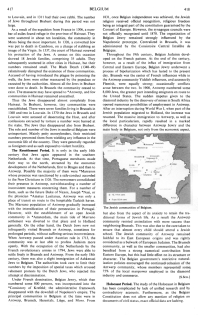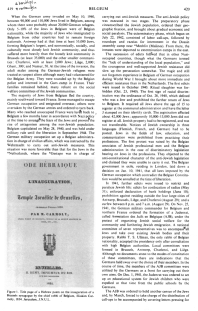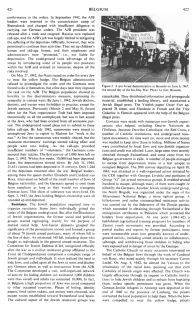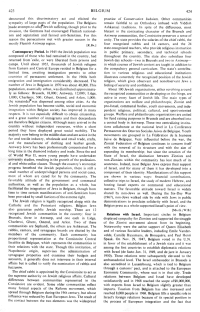Jews in Belgium 03: Holocaust 1940-1944<Holocaust Period.
German Jewish refugees - flight to France in 1940 - German military occupation - Flemish nationalism - edicts and resistance - Judenrat, Jewish schools, and Jewish badge - restrictions, forced labour, deportations - Jewish partisan groups
from: Belgium; In: Encyclopaedia Judaica 1971, vol. 4
presented by Michael Palomino (2008)
Share:
The solution is the Book of Life with Mother Earth - www.med-etc.com
[German Jewish refugees in Belgium]
The study of the Holocaust in Belgium has been complicated by lack of unified research and by contradictory accounts. Furthermore, as the Belgian Constitution does not allow any mention of religion on documents of civil status, exact official data are lacking. (col. 418)
[[The time of 1929-1939 is missing in this article. There was happening much in this time:
-- Jewish refugees from Germany were coming in and helped by Jewish organizations
-- the Belgian government made restrictions against further German Jewish refugees
-- and there were also some Polish Jewish refugees in Belgium.
see: Joint]].
When the German army invaded on May 10, 1940, between 90,000 and 110,000 Jews lived in Belgium, among whom there were probably about 20,000 German refugees. Only 5-10% of the Jews in Belgium were of Belgian nationality, while the majority of Jews who immigrated to Belgium from other countries had to remain foreign nationals. Antwerp had at that time at least 55,000 Jews, forming Belgium's largest, and economically, socially, and culturally most closely knit Jewish community, and thus suffered more heavily than the loosely knit community in Brussels (at least 35,000) and the other smaller communities:
-- Charleroi, with at least 2,000 Jews
-- Liège, 2,000
-- Ghent, 300;
-- and Namur, 50.
At that time of the invasion, the adult males among the German-Jewish refugees were treated as suspect aliens although many had volunteered for the Belgian Army. They were rounded up by the Belgian police and interned in the Gurs camp in France. Their families remained behind, many reliant on the social welfare committees of the Jewish communities.
[Jewish flight movement to France - German military occupation]
The majority of Jews from Belgium fled the country, mainly southward toward France. Some managed to escape German occupation and emigrated overseas; other were overtaken by the German armies and ordered to turn back. Many who reached unoccupied France were lured back to Belgium a few months later in accordance with Nazi policy at the time to assuage [[calm down]] the fears of the Jews and prevent the rise of antagonism among the non-Jewish population.
Belgium capitulated on May 28, 1940, and was held under military rule until the liberation in September 1944. [[Belgium was added two provinces from northern France]]. The German military occupation set up a Belgian administration in charge of civilian affairs, which was instructed by the Wehrmacht to carry out anti-Jewish measures. This situation was more favourable than that for the Jews in the *Netherlands, where the *Gestapo was in charge of (col. 419)
carrying out anti-Jewish measures. (col. 420)
[Discriminations - Flemish nationalism provoking more anti-Semitism and persecution of the Jews]
The Belgians made attempts to allay [[calm down]] Jewish suffering, though prior to the invasion, the Germans had encouraged Flemish nationalism and separatism and fanned anti-Semitism. For this reason the persecutions met with greater success in the mostly Flemish Antwerp region. (col. 423)
The anti-Jewish policy was executed in two stages. The preparatory phase circumscribed the Jewish population, ordered their geographic fixation, and brought about gradual economic and social paralysis.
[[...]]
[Edicts - and strong resistance movement]
The succession of edicts followed that in other Nazi-occupied countries, though what the Germans termed the "lack of understanding of the local population", and the courageous and well-supported Jewish resistance did slow up the persecution somewhat. The tragic and still not forgotten experience in Belgium of German occupation during World War I brought about more immediate and efficient resistance than in the Netherlands.
The first edicts were issued in October 1940. Ritual slaughter was forbidden (Oct. 23, 1940). The first sign of racial discrimination was the ordinance of Oct. 28, 1940, which defined who was a Jews and prohibited the further return of Jews to Belgium. It required all Jews above the age of 15 to register at the communal administration and have the letter J stamped on their identity cards. The registration affected about 42,000 Jews; apparently 10,000-13,000 Jews did not register at all. Jewish property had to be registered, and was not transferable. Notices of Jewish ownership in three languages (Flemish, French, and German) had to be posted. Jews in the fields of law, education, and communication were prohibited from practicing their professions.
The first protest was raised by the Belgian associates of Jewish professional men and the Belgian administration in the case of discriminatory legislation bearing on Jews in the professions. They objected to the anti-constitutional character of the anti-Jewish legislation and claimed they were unable to carry it out. The Belgian government in exile, residing in London, laid down a decision on Jan. 10, 1941, that all laws imposed by the German occupation which contradict the Belgian Constitution would be annulled at the time of liberation.
In 1941, further edicts were issued to restrict and paralyze Jewish life: edicts for confiscation of radios (May 31); enforced declaration of bank holdings (June 10); prohibition against residing outside the four large cities of Antwerp, Brussels, Liège, and Charleroi (August 29); and a curfew between 8 p.m. and 7 a.m. (August 29).
[Judenrat edict - Jewish schools]
On Nov. 25, 1941, the German military commander for Belgium and northern France ordered the formation of a Judenrat, called Association des Juifs en Belgique (AJB) [[Belgium Jewish Association]], under the pretext of organizing Jewish social welfare for the community and furthering Jewish emigration. A national committee of seven representatives was to encompass [[enclose]] all Jews and take over existing Jewish bodies and their property. Rabbi T.S. Ullman, the only rabbi of Belgian nationality, accepted the presidency only after consultation with high Belgian authorities.
Local committees were formed in Brussels, Antwerp, Charleroi, and Liège. Although no documents attest to the modes of constitution of these committees, there are indications that the Germans held sway over the choice of their members. In the course of time, the members of the AJB committees were utilized by the Germans as a front for carrying out their own aims. On Dec. 1, 1941, the Judenrat was ordered to set up an educational system for Jewish children who were expelled at that time from the public schools by the Germans.
The AJB was ordered to hold another census of the Jews, and by March, forced to take charge of the distribution of call-ups to be accompanied by covering letters pressing for (col. 420)
conformance to the orders. (col. 421)
[Jewish badge - profession restrictions - forced labour in "Organization Todt"]
On May 27, 1942, the Nazis issued an order for every Jews to wear the yellow badge. The Belgian administration refused to promulgate the order and the Germans were forced to do it themselves, but a few days later they imposed the task on the AJB. The Belgian population showed its hostility to this discriminatory measure, expressing its sympathy in various ways.
By June 1, 1942, Jewish doctors, dentists, and nurses were forbidden to practice, except for Jewish patients. Previously (March 2 and May 8), forced labour for the Nazi organization Todt had been imposed theoretically on all the unemployed, but was in fact aimed at the Jews, who had been evicted from all economic pursuit. The underground issued pleas not to submit to these labour call-ups.
By July 1942, summonses were issued to unemployed Jews to report to Malines for "work in the east". At first the summonses were meekly obeyed, but the resistance movements' warnings started taking effect and people went into hiding. (col. 421)
[Deportations and further measures of destruction - the work of the Judenrat: children's homes and old-age homes]
The exterminatory phase, which began on July 22, 1942, consisted of labour call-ups, followed by roundups and razzias for internment in the Dossin assembly camp near *Mechlin (Malines). From there, the inmates were deported to extermination camps in the east. (col. 420)
As the call-ups provided insufficient numbers of "volunteers", the Germans commenced their razzias. The first convoy of 1,000 Jews left on Sept. 2, 1942. Within five weeks, 10,000 had been deported. Later, the deportations slowed down. (col. 421)
In September 1942, the AJB leaders were interned in the concentration camp of Breendonck and charged with insufficient diligence in carrying out German orders. The AJB president was released after a week and resigned. Razzias now replaced call-ups, and the AJB's job was largely limited to mitigating the suffering of the deportees. Officially, however, they were permitted to continue their activities. They set up children's homes and old-age homes, and their employees and administrators were "protected", i.e., not liable for deportation. The underground took advantage of this status by introducing some of its people into positions within the AJB and utilized its resources, despite all the risks involved. (col. 421)
Belgian leaders, among them the queen mother Elisabeth and Cardinal van Roey, intervened on behalf of the small number of Jews of Belgian nationality, and the Germans agreed to omit them from expulsion as long as they would not transgress German laws. This show of tolerance was short-lived. On Sept. 3, 1943, the Jews holding Belgian citizenship were all rounded up and deported. (col. 421)
By July 31, 1944, 25,631 victims had been deported in 31 convoys. (col. 421)
Resistance.
[Belgian Jewish partisans - hiding and secret escape routes - cultural life in the Jewish resistance groups - money transfer]
The Jewish population required time to organize resistance. Some Jews individually joined the ranks of the Belgian underground. But after he dissolution of Jewish organizations, the former social and political groups started regrouping, mainly for the purpose of mutual social help. Anti-fascist elements grasped the significance of the persecutions sooner and formed a group of about 70 Jewish armed partisans, many of whom fell in the line of duty. An estimated 140 fell, including those who fought as individuals in the general armed resistance.
The Committee for Jewish Defence (DCJ, recognized officially after the war as a as a civilian resistance group affiliated to the Front de l'Indépendance) comprised a complete range of Jewish groups and individuals. It soon realized the need to hide Jews, and called upon all the Jews to resist and disobey any German edicts as well as instructions from the AJB [[from the Judenrat]]. The Committee developed a vast, well-organized network of activity for hiding children (an estimated 3,000 children were thus saved) and adults (an estimated 10,000). In fact, in Belgium a high proportion of Jews was saved compared to other occupied countries. Places of hiding, identity papers, food ration tickets, and money were obtained, and escape routes established toward Switzerland and Spain.
The cultural aspect of the Jewish resistance groups was (col. 421)
remarkable. They distributed information and propaganda material, established a lending library, and maintained a Jewish illegal press. The Yiddish paper Unzer Vort [[Our Word]] appeared 28 times, and Flambeau in French appeared with the help of the Belgian illegal press.
Contacts were made with numerous non-Jewish organizations who helped, including Oeuvre Nationale de l'Enfance [[National Children's Work]], Jeunnesse Ouvrière Catholique [[Catholic Youth Organization]], the Red Cross, a number of Catholic institutions, and underground resistance movements.
As time went on, more and more money was needed to keep alive those in hiding. Millions of francs were contributed by local Jews and non-Jewish organizations and credit was allotted. Later, large sums were secretly obtained through Switzerland, and some came from the Belgian government in exile.
[Flight from deportation train no. 20 - Ninth Brigade - (racist) Zionist resistance groups - training camps for Palestine - sabotage]
A number of people managed to escape from deportation trains in a feat unique to occupied Belgium. The 20th convoy departing on April 19, 1043, was attacked in a well-organized action initiated by the CDJ [[Committee for Jewish Defence]] together with Georges Livchitz and partisans of Group "G" (an armed resistance group). It enabled several hundred to escape, although many of them were caught or killed by the Germans.
Another Jewish underground group, the Ninth Brigade, was organized under the aegis of the Mouvement National Belge [[Belgian National Movement]], a more rightist group. A little-known and rather circumscribed resistance activity was carried out by the federation of the [[racist]] Zionist parties, which succeeded in obtaining through Switzerland a few immigration certificates to Palestine which protected the holders from deportation.
At one point (1941-42) hakhsharah (agricultural training program) for members of [[racist]] Zionist youth movements was provided. According to partial studies and reports by former participants, there were innumerable cases (not generally known) of underground activity, including armed attacks on collaborators, sabotage, and withdrawing those children in hiding who were exposed and in danger of arrest by the Gestapo.
[Examples of resistance of the Catholic Church]
The Catholic Church on many occasions intervened on behalf of the Belgian Jews through the work of Cardinal van Roey, who acted mainly through his secretary Canon Leclef. On Aug. 4, 1942, he alerted the Vatican to the inhumanity of the racial laws, pointing out that even Catholics of Jewish origin were affected. The Church was largely efficacious through its request of Catholic institutions to hide Jewish children and to refrain from baptizing them, unless specific permission was given. When the German-Jewish refugees in Antwerp were deported at the end of 1940 to the province of Limburg, the priests instructed thee local population to help them. When the Jews were compelled to wear the yellow badge, priests (col. 422)
denounced this discriminatory act and elicited the sympathy of large parts of the population.> (col. 423)
Č Ḥ ¦ Ẓ
ā ḥ ī ū ẓ
^
 previous
previous



